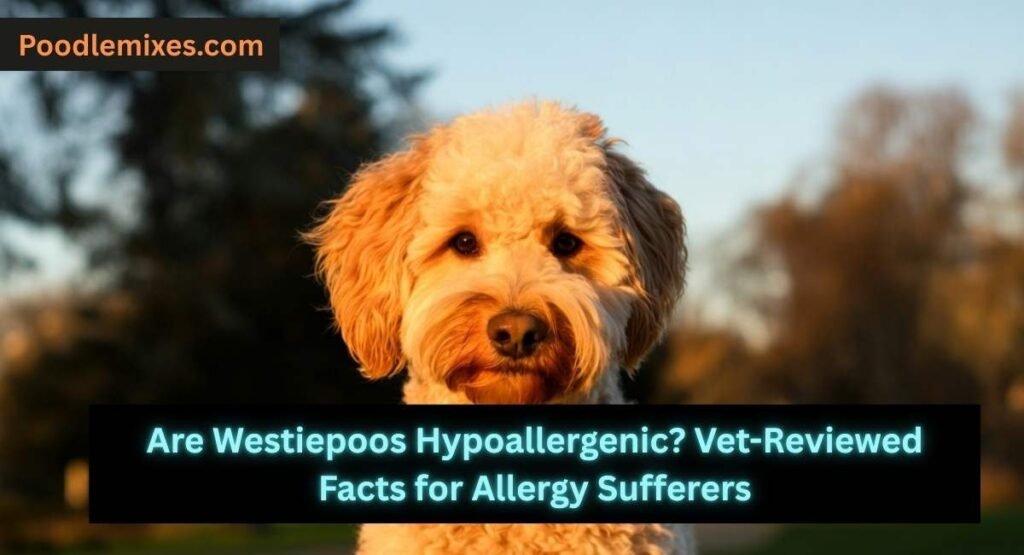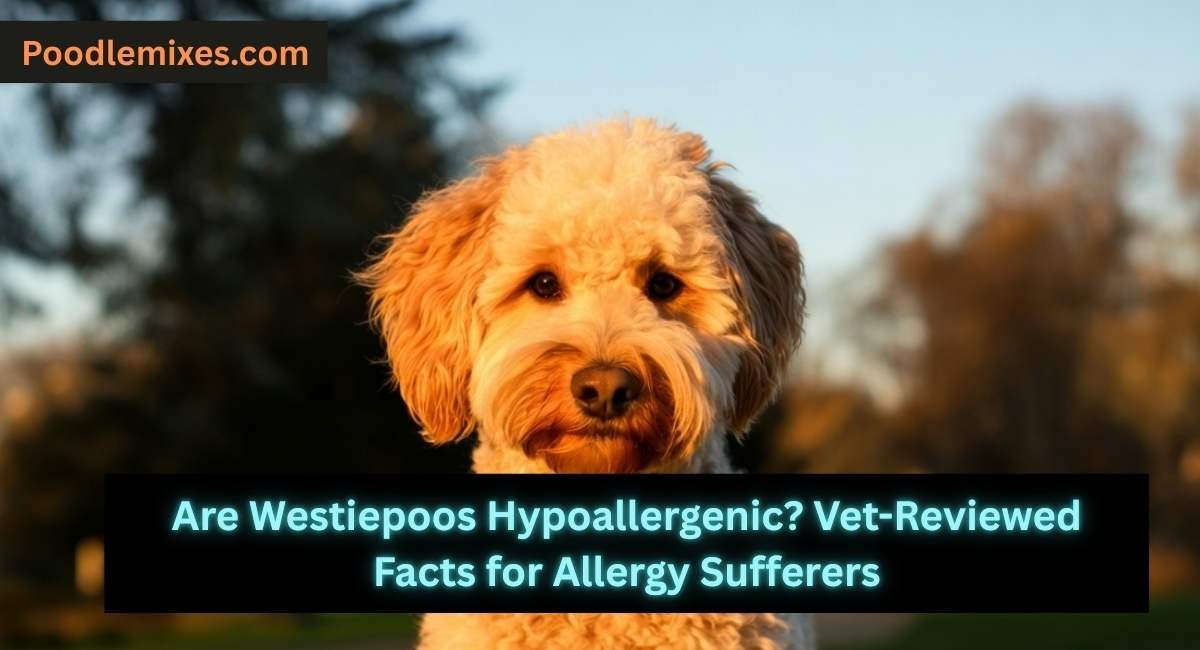Are Westiepoos hypoallergenic? This charming cross between a West Highland White Terrier and a Miniature or Toy Poodle is often promoted as an ideal small dog for allergy-prone families. Combining two breeds known for low-shedding coats certainly sounds promising. However, it’s essential to begin with the facts from experts like the American College of Allergy, Asthma, and Immunology: no dog is 100% hypoallergenic. While Westiepoos can be an excellent choice for many with mild sensitivities, understanding the nuances of their coat care and allergen production is key to a successful match. This guide explores the reality behind the hypoallergenic label for Westiepoos.

Are Westiepoos Hypoallergenic?
No, Westiepoos are not completely hypoallergenic, but they are considered one of the more suitable mixes for allergy sufferers. Both parent breeds—the West Highland White Terrier and the Poodle—have coats that shed minimally, which significantly reduces the amount of dander-filled hair released into your home. The American Lung Association explains that allergens are proteins in saliva, dander, and urine, not the hair itself. Since Westiepoos shed very little, they spread fewer allergens around. However, they still produce these allergens, so they are low-shedding and low-dander, but not allergen-free.
What Does Hypoallergenic Really Mean in Dogs?
The term “hypoallergenic” can create unrealistic expectations. Veterinarians and organizations like the American Kennel Club (AKC) use the term to describe breeds that are “less likely” to cause an allergic reaction, not “will not cause” one. This is typically due to a predictable, non-shedding coat that traps dander.
It’s important to balance this with scientific evidence. A study published in the Journal of Allergy and Clinical Immunology found that homes with dogs labeled “hypoallergenic” did not have lower levels of the primary dog allergen (Can f 1) than homes with other dogs. This reinforces that individual sensitivity and a specific dog’s allergen levels matter more than a breed label.
Westiepoo Coat Types and Allergen Impact
The Westiepoo can inherit a range of coat types, which directly affects its allergy-friendliness. The ideal coat for an allergy sufferer is one that is more Poodle-like.
The following chart outlines the common Westiepoo coat variations:
| Coat Type | Shedding Level | Dander Control | Allergy Risk (Relative) |
|---|---|---|---|
| Curly (Poodle-Dominant) | Very Low | Excellent | Lower |
| Wiry/Wavy (A Balanced Mix) | Low | Good | Low to Medium |
| Soft/Straight (Westie-Dominant) | Low (but more than curly) | Fair | Medium |
As VCA Animal Hospitals notes, a curly, non-shedding coat is most effective at trapping dander close to the skin. A wiry coat, similar to a Westie’s, still sheds very little but may require different grooming. Fortunately, unlike some mixes, most Westiepoos inherit a low-shedding coat, making them a relatively predictable choice.
Allergy Considerations for Westiepoo Owners
The Westiepoo’s small size is an unexpected advantage for allergy management. A smaller dog has less skin surface area, which can mean less overall dander production compared to a larger dog.
However, success depends on the individual. According to the National Institutes of Health (NCBI), allergen production varies from dog to dog. For people asking “are Westiepoos hypoallergenic,” the answer hinges on your specific allergies and the dog you choose. Their compact size makes it easier to arrange a prolonged visit with a specific Westiepoo before adoption, which is the best way to test your reaction.
Tips to Reduce Allergic Reactions With a Westiepoo
Managing a Westiepoo’s coat is crucial for minimizing allergens. Here are essential tips:
- Regular Professional Grooming: Schedule grooming every 4-6 weeks. Their curly or wiry hair can mat easily, and regular trims keep the coat manageable and reduce dander buildup. The AKC stresses the importance of professional grooming for non-shedding breeds.
- Frequent Brushing at Home: Brush your Westiepoo several times a week to remove loose hair and dander before it enters your environment.
- Bathing Routine: Bathe your dog every 3-4 weeks with a gentle, oatmeal-based or hypoallergenic shampoo to wash away allergens from their skin and coat.
- Leverage Their Small Size: Their small stature makes it easy to wipe their face and paws with a damp cloth after being outside to remove outdoor allergens and dried saliva.
- Maintain a Clean Home: Use a HEPA air purifier and vacuum with a HEPA filter regularly. The EPA confirms that this helps reduce airborne allergens. Wash their bedding frequently.
Other Poodle Mixes Often Considered “Hypoallergenic”
Westiepoos belong to the group of small Poodle mixes. Here’s a quick comparison:
| Breed | Typical Coat | Shedding Level | Allergy Friendliness* |
|---|---|---|---|
| Westiepoo | Curly/Wiry | Very Low | Higher |
| Cockapoo | Curly/Wavy | Low | Higher |
| Maltipoo | Soft/Silky | Very Low | Higher |
| Yorkipoo | Silky/Wavy | Very Low | Higher |
*Friendliness = relative chance of being allergy-manageable. Westiepoos are often a top contender due to both parents being low-shedding.
FAQ Section (People Also Ask)
Do Westiepoos shed a lot?
No, Westiepoos are very low-shedding dogs. They are not considered a non-shedding breed like a purebred Poodle, but they shed minimally, making them a good option for those who dislike dog hair around the house.
Are Westiepoos good for people with allergies?
They are one of the better small mixed breeds for people with allergies. Because both parent breeds shed very little, Westiepoos produce less airborne dander than many other dogs. However, someone with severe allergies should still proceed with caution and spend time with the dog first.
What is the best coat type for allergies?
A tight, curly coat that is as close to the Poodle parent as possible is best for allergy sufferers. This type of coat most effectively traps dander. When looking for a Westiepoo, an F1B cross (Westiepoo x Poodle) is most likely to have this desirable coat.
Conclusion
So, are Westiepoos hypoallergenic? In the truest sense, no dog is. However, the Westiepoo is a strong candidate for allergy-sensitive homes due to its low-shedding lineage from both parents and its manageable small size. Their potential to be a wonderful, allergy-friendly companion is high, but it requires a commitment to consistent grooming and a realistic understanding of pet allergies. The final, most important steps are always to consult your allergist and spend quality time with a Westiepoo to ensure a happy and healthy life together.
